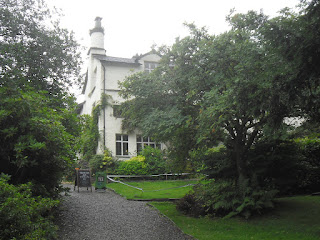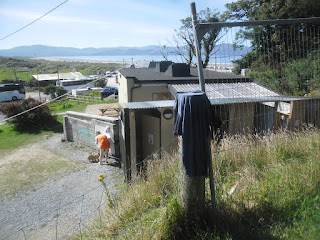Outside St. Barnabas church, I tried to take pictures of the place from all angles, as, for me, it was the jewel in the crown of Oxford.
Being known as an Anglican high church, it wasn't surprising to see Mass and Benediction offered by a parish priest (all Catholic religious terminology, of course):
And inside, we saw the high altar, stations of the cross, elevated pulpit etc.
Also, the sound of a man doing solemn-sounding organ practice kind of made the empty church come alive.
My friend, a non-practising Anglican (and believer without belonging), went in first and came out saying that he'd had some kind of spiritual experience, as he'd felt something profound inside.
While taking a shot of the rear end of the St. Barnabas building:
I saw a short list of famous people, including Thomas Hardy, who were in one way or another connected to the church:
Through quickly searching the Internet, and finding an interesting article entitled Clement Shaw on Jericho's role in Jude the Obscure (https://www.jerichocentre.org.uk/about_jericho/about_arts_item/thomas-hardy-in-jericho), I've just discovered that the suburb nicknamed Beersheba where Jude Fawley takes cheap lodgings seems to be a reference to the Jericho district of Oxford (Hardy's Christminster).
At the tender age of 16, Thomas Hardy worked as an apprentice for the architect and church restorer, John Hicks, in Dorchester.
Moreover, between 1862 and 1867, Hardy is known to have been the assistant architect to Arthur Blomfield who was commissioned by Thomas Combe to design St. Barnabas church:
Besides being pre-Raphaelites, Thomas Combe and his wife were prominent high church (Tractarian Movement) people in the Church of England.
In his article, Clement Shaw (2022) reveals that the Combes instructed Blomfield to design a church in Romanesque style like Torcello Cathedral near Venice.
Moreover, St. Barnabas church was completed in 1869, with Jude the Obscure being published 30 years later when Hardy was 58, with the novel making many references to the Tractarians and the kind of influence they had on Jude and his cousin (forbidden fruit) lover, Sue Bridehead.
From all this, Clement Shaw concludes that the young Thomas Hardy's work-related association with Jericho and St. Barnabas church must've played a big part in helping to inspire one of the greatest passionate and tragic English novels ever written.
Indeed, Jude the Obscure is a deeply profound and moving account of one man's tragically failed attempt to access high cultural (academic and religious) joy and enrichment, as the cloistered walls of Christminster look down on him and don't treat him seriously.
For me, there are four truly great novels in English Literature: both Tess and Jude by Hardy, and The Rainbow and Sons and Lovers by D.H. Lawrence who was a massive Hardy fan, of course. I would also be tempted to include Hardy's The Woodlanders; The Mayor of Casterbridge; and The Return of the Native on this list.
For me, Hardy's great tragedies are painfully sublime, as ordinary, everyday characters dare to dream and try to build higher passionate lives, with the mechanics of wider society not allowing them to do so.
























































